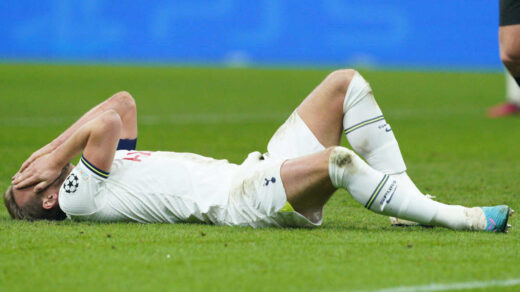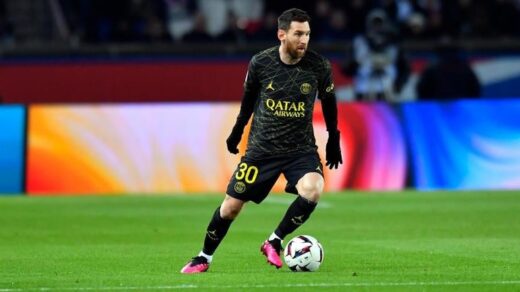“Stop it going in our net and try and put one in their net,” is how Sean Dyche summarised his tactical plan following Everton’s surprise 1-0 victory over table-toppers Arsenal.
“The bit in the middle I wasn’t too worried about,” he added.
Sounds simple enough. But it’s not a sentiment you could ever imagine being parroted by Manchester City boss Pep Guardiola. The era-defining tactician has made a career out of obsessing about “the bit in the middle”.
The interesting thing about Erling Haaland is that he looks like a player more attuned to the Dychian fundamentals of the game than the complex and sophisticated Juego de Posicion of Guardiola’s Tiki-Taka.
Haaland, when it comes to “putting one in their net”, has kept his side of the bargain. Emphatically so. He’s scored 25 goals in his first 20 Premier League appearances and 31 in all competitions – he’s well on his way to breaking his own record for the fastest route to 50 goals in a major European league.
The Norway international is like a lab-made No.9. Ridiculously quick. Cartoonishly strong. Absolutely deadly with his one-touch finishing in the penalty area. It’s as if someone took the DNA of former City striker Niall Quinn and juiced every attribute to the max.
In just over half a season, Haaland has scored 10 more goals than City’s top scorer in the Premier League and seven more goals in all competitions from last term. One more goal and Haaland will match Sergio Aguero’s best-ever tally for a Premier League campaign. There are still 17 matches left to play.
So why, with all those goals, don’t City look any better?
The Ronaldo debate rehashed
The conversation around Haaland recalls the noise around Cristiano Ronaldo’s return to Manchester United last summer.
The legendary Portuguese goalscorer – arguably the greatest in the history of the game – coincided with a dramatic downturn in the club’s performances.
United had finished second the season prior and enjoyed a strong start to 2021-22 before Ronaldo’s late summer arrival. Things soon took a nosedive, Ole Gunnar Solskjaer was sacked and interim successor Ralf Rangnick failed to get the ship back on course.
They ended up finishing sixth with their lowest points tally of the Premier League era. Ronaldo’s many acolytes in the media insisted he wasn’t the problem.
“He’s apparently the problem” tweeted Rio Ferdinand, complete with six laughing emojis, after the forward scored an injury-time equaliser against Atalanta in the Champions League.
Whatever Ronaldo’s faults, goalscoring wasn’t a problem – he scored a more than respectable 18 goals in the Premier League and 24 in all competitions.
Similarly, sarcastic responses were aired after Haaland scored a hat-trick – his fourth of the season – at home to Wolves. How can he possibly be a problem with output like that?
👀 Natalie: “Has Erling Haaland made Manchester City worse?”
😳 Stuart: “Absolutely ludicrous! What’s he going to do, apologise for scoring 20-odd goals?!”
Stuart Pearce doesn’t believe Erling Haaland has made #MCFC worse! 🤔 pic.twitter.com/IWjp7l9p2o
— talkSPORT (@talkSPORT) January 15, 2023
That question ignores the collective context.
It wouldn’t be fair to compare Haaland and Ronaldo like-for-like. For one, Haaland is 15 years younger than Ronaldo was last season. He’s far more mobile, covers more ground and presses more. He’s even more potent in front of goal.
As with Ronaldo last season, it also wouldn’t be fair to view all of City’s struggles through the lens of one player. Haaland is not responsible for the issues between Guardiola and Cancelo, or the defensive lapses, just as Ronaldo wasn’t responsible for the post-Euros drop in form from Luke Shaw, Marcus Rashford, Jadon Sancho and Harry Maguire.
But the fundamental question is the same – does this cog fit the machine?
Pep Guardiola’s history with strikers
As one listener of the brilliant Second Captains podcast noted, you can view Guardiola’s history with strikers akin to The Sopranos’ Bobby Bacala and his attitude to hunting.
After gifting Tony Soprano a rife, he says: “I wouldn’t use a firearm like this on a deer, it’s unsportsmanlike. Last two seasons I’ve been using a bow & arrow exclusively.”
It’s almost like classic, traditional No.9s are anathema to Guardiola’s idea of how football should be played. Too simple. Too obvious. Too easy. Think of the coach’s best teams and they don’t feature a classic penalty-box striker.
Zlatan Ibrahimovic famously didn’t gel with the Catalan coach at Barcelona. “The ‘Philosopher’ prefers players who obey without talking back,” the Swede recalled.
Guardiola reportedly didn’t even want Robert Lewandowski at Bayern Munich. It was the board, rather than the coach, that made the decision to sign him as a free agent in 2014.
“Robert Lewandowski is No1 striker in world but do Bayern Munich need him?” was the headline of a Dietmar Hamann column in The Guardian that’s eerily prescient of the conversation around Haaland at City eight years later.
Even Aguero looked an awkward fit with Guardiola in their first few years together. It was only once City’s all-time top scorer adapted a more fluid game that he earned his manager’s love.
It will be fascinating to see Haaland’s trajectory. Will he outlast Guardiola ala Lewandowski? Will he adapt his game like Aguero? Or are the pair destined for an Ibrahimovic-esque bust-up?

READ: The last six strikers Pep Guardiola signed & how they fared: Ibra, Jesus…
Man City’s regression
The fact is that City aren’t seeing the same returns as they did last season.
Last season they averaged 2.44 points per game in the Premier League. This season that’s dropped to 2.14 points per game this season. They have eight fewer points than they did after the same number of games last season.
Most strikingly of all, despite boasting the best goalscorer in the world, City collectively aren’t scoring more. They’ve notched the same number of goals (53) as they had at this stage last term.
Defensively, Guardiola’s side are not as sound. They’ve kept three fewer clean sheets. They’ve conceded eight more goals.
It would be an act of folly to level that at Haaland’s door – what could the Norwegian have done about the errors that led to Harry Kane’s match-winner for Tottenham, for example?
But it’s also worth considering the collective front-to-back, back-to-front manner in which Guardiola’s teams have traditionally protected the goalkeeper with patterns of organised pressing without the ball and suffocating the opposition of opportunities by carefully looking after it when they have it.
Does playing direct to a centre-forward making runs into the box make them more susceptible to losing the ball in dangerous areas? It’s undeniable that Haaland doesn’t get as involved in City’s play as Gabriel Jesus, the man he replaced.
Last season, Jesus averaged 30 passes per 90 minutes in the Premier League for City and 48.9 touches per 90 minutes – 30.3 in the final third. Contrast that to Haaland, who averages 11 passes per 90 minutes, 24.2 touches per 90 minutes and 13.2 in the final third.
City are a different type of team with Haaland as a focal point. They have also seen a drop off in results following that change.
Surely they can be just as successful with Haaland – but do they need to adapt to him, or does he need to adapt to him? Time will tell. Watch this space.
READ NEXT: 10 big PL names Erling Haaland has already outscored: Yeboah, Saka…
TRY A QUIZ: Can you name Guardiola’s 30 most-used players throughout his career?



